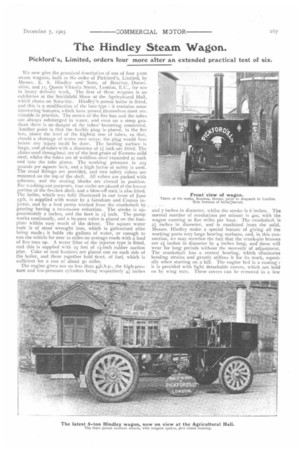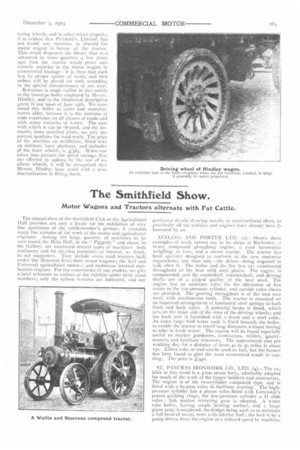The Hindley Steam Wagon.
Page 11

Page 12

Page 13

If you've noticed an error in this article please click here to report it so we can fix it.
Pickford's, Limited, orders four more after an extended practical test of six.
We now give the promised description of one of four 5-ton steam wagons, built to the order of Pickford's, Limited, by Messrs. E. S. Hindlev and Sons, of Bourton, Dorsetshire, and I I, Queen Victoria Street, London, E.C., for use in heavy delivery work. The first of these wagons is on exhibition at the Smithfield Show at the Agricultural Hall, which closes on Saturday. Hindley's patent boiler is lilted, and this is a modification of the loco type : it contains some interesting features, which have proved themselves most serviceable in practice. The crown of the fire box and the tubes are always submerged in water, and even on a steep gradient there is no danger of the tubes' becoming uncovered. Another point is that the fusible plug is placed, in the fire box, above the level of the highest row of tubes, so that, should a shortage of water ever occur, the plug would fuse before any injury could be done. The heating surface is large, and 48 tubes with a diameter of II inch are fitted. The plates used throughout are of the best grade of Siemens mild steel, whilst the tubes are of weldless steel expanded at each end into the tube plates. The working pressure is 225 pounds per square inch, and a high factor of safety is used. The usual fittings are provided, and two safety valves are mounted on the top of the shell. All valves are packed with asbestos, and the seating blocks are riveted in position. For washing-out purposes, four cocks are placed at the lowest portion of the fire-box shell, and a blow-off cock is also fitted. The boiler, which was fully illustrated in our issue of June Isth, is supplied with water by a Gresham and Craven injector, and by a feed pump worked from the crankshaft by gearing having a two-to-one reduction. The stroke is approximately 2 inches, and the bore is ill inch. The pump works continually, and a by-pass valve is placed on the footplate within easy reach of the driver_ The square water tank is of stout wrought iron, which is galvanised after being made; it holds 18o gallons of water, or enough to run the vehicle for over JO miles on average roads with a load of five tons up. A water lifter of the injector type is fitted, and this is supplied with 25 feet of ti-inch rubber suction pipe. Coke or coal bunkers are placed one on each side of the boiler, and these together hold 6cwt. of fuel, which is sufficient for a run of about so miles.
The engine gives out no less than 45b.h.p., the high-pressure and low-pressure cylinders being respectively 41 inches
and 7 inches in diameter, whilst the stroke is 6 inches. The normal number of revolutions per minute is 400, with the wagon running at five miles per hour. The crankshaft is 21 inches in diameter, and is machined from the solid. Messrs. Hindley make a special feature of giving all the working parts very large bearing surfaces, and, in this connection, we may mention the fact that the crank-pin brassesare 21 inches in diameter by 4 inches long, and these will wear for long periods without the necessity of adjustment. The crankshaft has a central bearing, which eliminates bending strains and greatly stiffens it for its work, especially when starting on a hill. The engine bed is a casting : it is provided with light detachable covers, which are held: on by wing nuts. These covers can be removed in a few minutes, when the whole of the engine is accessible for small adjustmentsto be made. The bottom of the bed forms an oil bath, in which all the working parts of the engine dip when running, and this is provided with a fixed funnel at the side for replenishing the oil supply front time to ritnO, All the bearings are of a special quality of gun metal, nod the cross-head slides are adjustable, so that it is impossible for them to wear out of line. The transmission is entirely by gearing, no chains being used. The wheels on the intermediate shaft and their pinions are cut from the solid_ An extension on the left-hand end of the crankshaft carries two sliding pinions, and either of these can be made to mesh with one of two wheels on the intermediate shaft-. The centre of this shalt carries a helical-toothed pinion, which drives a gear vheel of relatively large diameter bolted round the cage of the differential gearing. Change of speed ratio is effected by means of it small horizontal lever placed in front of the first shaft, and the driver has to dismount to move in The hack axle is in one piece, the right-hand driving wheel being carried on it sleeve which projects inwards and carries one of the bevel wheels belonging to the differential gearing. .k locking device. is Fitted for use on greasy roads, or when running up a slippery gradient.
The frame is an excellent piece of work, and is built up from channel steel with a Suction of 51 inches deep by 2,1.■
inches wide, and five transverse stays are fitted to give additional strength. The back axle is a solid steel forging, with a diameter of 4 inches, whilst the wheel journals are 8 inches in length ; the front axle is of II-section steel, with a section of
inches by 3 inches, and the journals arc 2 2, inches in diameter by 8 inches long. Steering is on the Ackermann principle, and its construction throughout is worthy of attention as being very stiff and having large knuckle joints and pins. Gary patent wheels are fitted on the wagon in question, is Pickford's, Limited, has been !.ittistied with the results given by those in use on their siearn tractors.
The vehicle has been designed to carry a maximum load of five tons and to draw an additional weight of two to three tons on a trailer, or a joint useful load of seven Ions in all, Thu length over all is 19 feet, and the wheel base is To feet, whilst the width over the axle caps is 6 feet to inches. Pickford's, Limited, has had six similar wagonsto the one described above, all of which have given the greatest satisfaction in hard daily service round London anti elsewhere. One of these has been in constant use for the last 12 months, and has covered an approximate distance of ten thousand miles : working adjustments have all been done without keeping the vehicle off the road. All users, and those who are interested in ihe self-propelled vehicle question should take the first opportunity of making a thorough inspection of this the latest type of steam lorry manufactured by klessrs. S. Hindlev and Sons. It is a thoroughly good engineering job, and one calculated to stand up to bard usage in any part of Grcntt Britain or the Colonies. ln concluding our short descriptive account of the Hindley Leant wagon, it will not be oitt of place to draw attention to the experience of Pickford's, Limited, by way of comparison I.eitk (Jen tractors and self-contained motor wagons. We are Iii ii position to state that experience has proved the exh;tprice of scope for both classes of mechanical transport, and it is certainly been disproved that the independent tractor ran do the whole range of work which comes within the purview of a haulage contractor. One difficulty in connection with tractors, which could hardly be appreciated in the early days, was the expenditure required to put ordinary VflflS into proper legal trim for haulage by a tractor, and the practical difficulty of securing a real and complete interchange between the vehicles hauled has been by no means inconsiderable. After every allowance is made, however, for the existence of this expenditure upon brake tackle and re
tyring wheels, and in other minor respects, it is evident. that Pickford's, Limited, has not found any occasion to discard the motor wagon in favour of the tractor. This result disproves the theory that was advanced in sonic quarters a few years ago that the tractor would prove universally superior to the motor wagon in commercial haulage : it is clear that each has its proper sphere of work, and that orders will be placed for each according to the special circumstances of any case.
Reference is made earlier in this article to the loco-type boiler employed by Nlessrs. Hindley, and to the illustrated description given in our issue of June Isth. We commend this boiler to users and manufacturers alike, because it is the outcome of wide experience on all classes of roads and with many varieties of water. The ease with which it can be cleaned, and the hnmunity from scorched joints, are very important qualities for road work. The price of the machine on exhibition, fitted with an ordinary lorry platform, and inclusive of the Gam wheels, is .4:58s. When one takes into account the great sayings that are effected in upkeep lw the use of resilient wheels, it will be recognised that Messrs. Hindley have acted with a wise discrimination in fitting them.






















